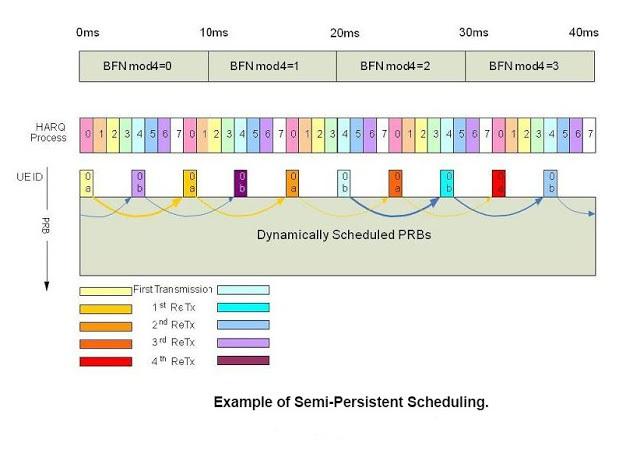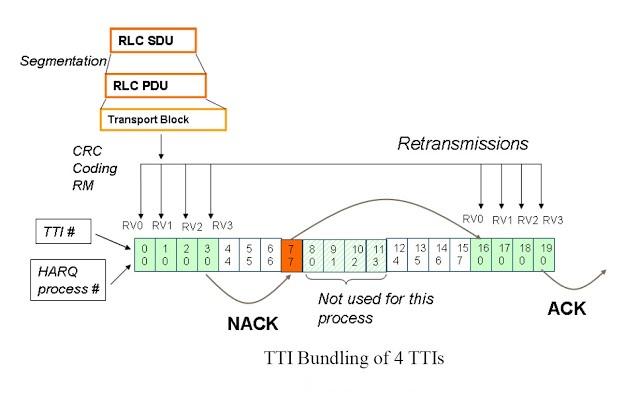With the support of emergency and location services in Rel-9, interest in Voice over LTE (VoLTE) has increased. This is because the Rel-9 enhancements to support e911 were the last step to enable VoLTE (at least in countries that mandate e911) since the Rel-8 specifications already included the key LTE features required to support good coverage, high capacity/quality VoLTE. There are two main features in Rel-8 that focus on the coverage, capacity and quality of VoLTE: Semi-Persistent Scheduling (SPS) and TTI Bundling.
SPS is a feature that significantly reduces control channel overhead for applications that require persistent radio resource allocations such as VoIP. In LTE, both the DL and UL are fully scheduled since the DL and UL traffic channels are dynamically shared channels. This means that the physical DL control channel (PDCCH) must provide access grant information to indicate which users should decode the physical DL shared channel (PDSCH) in each subframe and which users are allowed to transmit on the physical UL shared channel (PUSCH) in each subframe. Without SPS, every DL or UL physical resource block (PRB) allocation must be granted via an access grant message on the PDCCH. This is sufficient for most bursty best effort types of applications which generally have large packet sizes and thus typically only a few users must be scheduled each subframe. However, for applications that require persistent allocations of small packets (i.e. VoIP), the access grant control channel overhead can be greatly reduced with SPS.
SPS therefore introduces a persistent PRB allocation that a user should expect on the DL or can transmit on the UL. There are many different ways in which SPS can setup persistent allocations, and Figure below shows one way appropriate for VoLTE. Note that speech codecs typically generate a speech packet every 20 ms. In LTE, the HARQ interlace time is 8 ms which means retransmissions of PRBs that have failed to be decoded can occur every 8 ms. Figure below shows an example where a maximum of five total transmissions (initial transmission plus four retransmissions) is assumed for each 20 ms speech packet with two parallel HARQ processes. This figure clearly shows that every 20 ms a new “first transmission” of a new speech packet is sent. This example does require an additional 20 ms of buffering in the receiver to allow for four retransmissions, but this is generally viewed as a good tradeoff to maximize capacity/coverage (compared to only sending a maximum of two retransmissions).

The example in Figure above can be applied to both the DL and UL and note that as long as there are speech packets arriving (i.e. a talk spurt) at the transmitter, the SPS PRBs would be dedicated to the user. Once speech packets stop arriving (i.e. silence period), these PRB resources can be re-assigned to other users. When the user begins talking again, a new SPS set of PRBs would be assigned for the duration of the new talkspurt. Note that dynamic scheduling of best effort data can occur on top of SPS, but the SPS allocations would take precedent over any scheduling conflicts.

TTI bundling is another feature in Rel-8 that optimizes the UL coverage for VoLTE. LTE defined 1 ms subframes as the Transmission Time Interval (TTI) which means scheduling occurs every 1 ms. Small TTIs are good for reducing round trip latency, but do introduce challenges for UL VoIP coverage. This is because on the UL, the maximum coverage is realized when a user sends a single PRB spanning 180 kHz of tones. By using a single 180 kHz wide PRB on the UL, the user transmit power/Hz is maximized. This is critical on the UL since the user transmit power is limited, so maximizing the power/Hz improves coverage. The issue is that since the HARQ interlace time is 8 ms, the subframe utilization is very low (1/8). In other words, 7/8 of the time the user is not transmitting. Therefore, users in poor coverage areas could be transmitting more power when a concept termed TTI bundling (explained in the next paragraph) is deployed.
While it’s true that one fix to the problem is to just initiate several parallel HARQ processes to fill in more of the 7/8 idle time, this approach adds significant IP overhead since each HARQ process requires its own IP header. Therefore, TTI bundling was introduced in Rel-8 which combined four subframes spanning 4 ms. This allowed for a single IP header over a bundled 4 ms TTI that greatly improved the subframe utilization (from 1/8 to 1/2) and thus the coverage (by more than 3 dB).
The purpose of TTI Bundling is to improve cell edge coverage and in-house reception for voice. When the base station detects that the mobile can't increase it's transmission power and reception is getting worse it can instruct the device to activate TTI bundling and send the same packet but with different error detection and correction bits in 2, 3 or even 4 consecutive transmit time intervals. The advantage over sending the packet in a single TTI and then detecting that it wasn't received correctly which in turn would lead to one or more retransmissions is that it saves a lot of signaling overhead. Latency is also reduced as no waiting time is required between the retransmissions. In case the bundle is not received correctly, it is repeated in the same way as an ordinary transmission of a packet. For details how the feature is implemented have a look at 3GPP TS 36.321.
